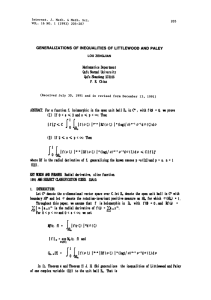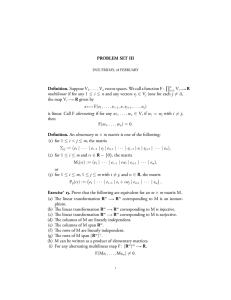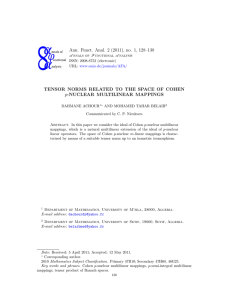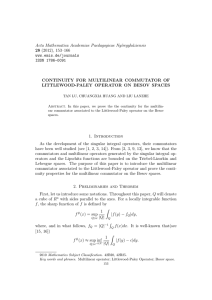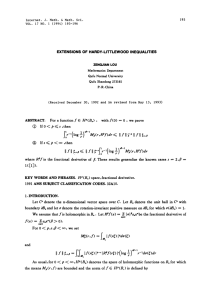WEIGHTED BOUNDEDNESS OF MULTILINEAR LITTLEWOOD–PALEY OPERATORS FOR THE EXTREME CASES OF p
advertisement
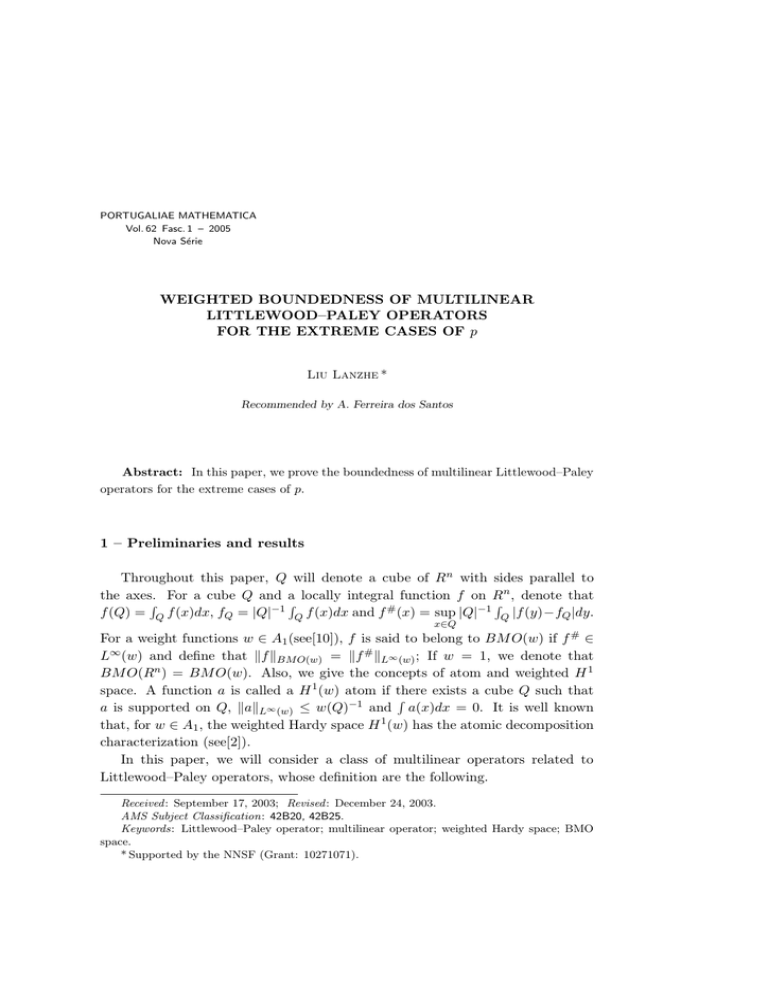
PORTUGALIAE MATHEMATICA
Vol. 62 Fasc. 1 – 2005
Nova Série
WEIGHTED BOUNDEDNESS OF MULTILINEAR
LITTLEWOOD–PALEY OPERATORS
FOR THE EXTREME CASES OF p
Liu Lanzhe *
Recommended by A. Ferreira dos Santos
Abstract: In this paper, we prove the boundedness of multilinear Littlewood–Paley
operators for the extreme cases of p.
1 – Preliminaries and results
Throughout this paper, Q will denote a cube of Rn with sides parallel to
the axes. For a cube Q and a locally integral function f on R n , denote that
R
R
R
f (Q) = Q f (x)dx, fQ = |Q|−1 Q f (x)dx and f # (x) = sup |Q|−1 Q |f (y)−fQ |dy.
x∈Q
For a weight functions w ∈ A1 (see[10]), f is said to belong to BM O(w) if f # ∈
L∞ (w) and define that kf kBM O(w) = kf # kL∞ (w) ; If w = 1, we denote that
BM O(Rn ) = BM O(w). Also, we give the concepts of atom and weighted H 1
space. A function a is called a H 1 (w) atom if there exists a cube Q such that
R
a is supported on Q, kakL∞ (w) ≤ w(Q)−1 and a(x)dx = 0. It is well known
that, for w ∈ A1 , the weighted Hardy space H 1 (w) has the atomic decomposition
characterization (see[2]).
In this paper, we will consider a class of multilinear operators related to
Littlewood–Paley operators, whose definition are the following.
Received : September 17, 2003; Revised : December 24, 2003.
AMS Subject Classification: 42B20, 42B25.
Keywords: Littlewood–Paley operator; multilinear operator; weighted Hardy space; BMO
space.
* Supported by the NNSF (Grant: 10271071).
26
LIU LANZHE
Let
(1)
(2)
(3)
ψ be a fixed function which satisfies the following properties:
R
ψ(x) dx = 0,
|ψ(x)| ≤ C(1 + |x|)−(n+1) ,
|ψ(x + y) − ψ(x)| ≤ C|y|(1 + |x|)−(n+2) when 2|y| < |x|.
Let m be a positive integer and A be a function on Rn . We denote that
n+1
Γ(x) = {(y, t) ∈ R+
: |x−y| < t} and the characteristic function of Γ(x) by χΓ(x) .
The multilinear Littlewood–Paley operator is defined by
SψA (f )(x)
where
=
"Z
Γ(x)
|FtA (f )(x, y)|2
dy dt
tn+1
#1/2
,
Rm+1 (A; x, z)
f (z) ψt (y − z) dz ,
|x − z|m
X 1
Rm+1 (A; x, y) = A(x) −
DαA(y) (x − y)α ,
α!
|α|≤m
FtA (f )(x, y)
=
Z
Rn
the derivatives D αA are understood in the distributional sense and ψt (x) =
t−n ψ(x/t) for t > 0. We denote that Ft (f ) = f ∗ ψt . We also define
Sψ (f )(x) =
ÃZ
dy dt
|Ft (f )(y)| n+1
t
Γ(x)
2
!1/2
,
which is the Littlewood–Paley operator (see [18]).
n
Let H be the Hilbert space H = h : khk =
³R R
n+1
R+
|h(t)|2 dy dt/tn+1
´1/2
o
<∞ .
Then for each fixed x ∈ Rn , FtA (f )(x, y) may be viewed as a mapping from
(0, +∞) to H, and it is clear that
°
°
°
°
SψA (f )(x) = °χΓ(x) FtA (f )(x, y)°
and
We also consider the variant of SψA , which is defined by
S̃ψA (f )(x)
=
where
F̃tA (f )(x, y)
and
=
"Z
Z
Rn
Γ(x)
°
°
°
°
Sψ (f )(x) = °χΓ(x) Ft (f )(y)° .
|F̃tA (f )(x, y)|2
dy dt
tn+1
#1/2
,
Qm+1 (A; x, z)
ψt (y − z) f (z) dz
|x − z|m
Qm+1 (A; x, z) = Rm (A; x, z) −
X
DαA(x) (x − z)α .
|α|=m
27
...MULTILINEAR LITTLEWOOD–PALEY OPERATORS...
Note that when m = 0, SψA is just the commutator of Littlewood–Paley operator (see [1],[15],[16]). It is well known that multilinear operators, as an extension
of commutators, are of great interest in harmonic analysis and have been widely
studied by many authors (see [4–9],[12–14]). In [11],[17], the endpoint boundedness properties of commutators generated by the Calderon–Zygmund operator
or fractional integral operator with BMO functions are obtained. The main purpose of this paper is to study the boundedness of the multilinear Littlewood–Paley
operators for the extreme cases of p. We shall prove the following theorems in
Section 3.
Theorem 1. Let D αA ∈ BM O(Rn ) for |α| = m and w ∈ A1 . Then SψA
maps L∞ (w) continuously into BM O(w).
Theorem 2. Let D αA ∈ BM O(Rn ) for |α| = m and w ∈ A1 . Then S̃ψA
maps H 1 (w) continuously into L1 (w).
Theorem 3. Let D αA ∈ BM O(Rn ) for |α| = m and w ∈ A1 . Then SψA
maps H 1 (w) continuously into weak L1 (w).
Remark. In general, SψA is not (H 1 (w), L1 (w)) bounded.
2 – Some Lemmas
We begin with some preliminary lemmas.
Lemma 1 (see [7]). Let A be a function on Rn and DαA ∈ Lq (Rn ) for
|α| = m and some q > n. Then
|Rm (A; x, y)| ≤ C|x − y|
m
X
|α|=m
Ã
1
|Q̃(x, y)|
Z
α
Q̃(x,y)
q
!1/q
|D A(z)| dz
,
√
where Q̃(x, y) is the cube centered at x and having side length 5 n |x − y|.
Lemma 2 (see [3]). Let Tb be the commutator defined by
Tb f (x) =
Z
b(x) − b(y)
f (y) dy .
|x − y|n
If w ∈ A1 , 1 < p < ∞ and b ∈ BM O(Rn ). Then Tb is bounded on Lp (w).
28
LIU LANZHE
Lemma 3 (see [8],[9]). Let TA be the multilinear operator defined by
TA f (x) =
Z
Rm+1 (A; x, y)
f (y) dy .
m+n
Rn |x − y|
If w ∈ A1 , 1 < p < ∞, 1 < r ≤ ∞, 1/q = 1/p + 1/r and D α A ∈ BM O(Rn ) for
|α| = m. Then TA is bounded from Lp (w) to Lq (w), that is
kTA (f )kLq (w) ≤ Ckf kLp (w) .
Lemma 4. Let w ∈ A1 , 1 < p < ∞, 1 < r ≤ ∞, 1/q = 1/p + 1/r and
DαA ∈ BM O(Rn ) for |α| = m. Then SψA is bounded from Lp (w) to Lq (w), that
is
kSψA (f )kLq (w) ≤ C
X
|α|=m
kDαAkBM O kf kLp (w) .
Proof: By Minkowski inequality and the condition of ψ, we have
|f (z)| |Rm+1 (A; x, z)|
SψA (f )(x) ≤
n
|x − z|m
R
Z
ÃZ
dydt
|ψt (y − z)|2 1+n
t
Γ(x)
|f (z)| |Rm+1 (A; x, z)|
≤C
n
|x − z|m
R
ÃZ Z
∞
|f (z)| |Rm+1 (A; x, z)|
≤C
|x − z|m
Rn
ÃZ Z
∞
Z
Z
0
0
|x−y|≤t
|x−y|≤t
!1/2
dz
dydt
t−2n
2n+2
(1 + |y−z|/t)
t1+n
22n+2 · t1−n
dydt
(2t + |y−z|)2n+2
!1/2
dz
!1/2
dz ,
noting that 2t + |y − z| ≥ 2t + |x − z| − |x − y| ≥ t + |x − z| when |x − y| ≤ t and
Z
∞
0
t dt
= C |x − z|−2n ,
(t + |x − z|)2n+2
we obtain
SψA (f )(x)
∞
t dt
|f (z)| |Rm+1 (A; x, z)|
≤ C
m
2n+2
|x − z|
0 (t + |x − z|)
Rn
Z
|f (z)| |Rm+1 (A; x, z)|
dz ,
= C
|x − z|m+n
Rn
Z
thus, the lemma follows from Lemma 3.
µZ
¶1/2
dz
...MULTILINEAR LITTLEWOOD–PALEY OPERATORS...
29
3 – Proofs of Theorems
Proof of Theorem 1: We have only to prove that there exists a constant
CQ such that
Z
1
|S A (f )(x) − CQ | w(x) dx ≤ C kf kL∞ (w)
w(Q) Q ψ
√
holds for any cube Q. Fix a cube Q = Q(x0 , l). Let Q̃ = 5 nQ and Ã(x) =
P 1
α
α
α
α
α
A(x) −
α! (D A)Q̃ x , then Rm (A; x, y) = Rm (Ã; x, y) and D Ã = D A−(D A)Q̃
|α|=m
for |α| = m. We write, for f1 = f χQ̃ and f2 = f χRn \Q̃ ,
FtA (f )(x) = FtA (f1 )(x) + FtA (f2 )(x) ,
then
1
w(Q)
Z
Q
|SψA (f )(x) − SψA (f2 )(x0 )| w(x) dx =
¯
¯
1
¯
¯
=
¯kχΓ(x) FtA (f )(x, y)k − kχΓ(x) FtA (f2 )(x0 , y)k¯ w(x) dx
w(Q) Q
Z
1
S A (f1 )(x) w(x) dx
≤
w(Q) Q ψ
Z °
°
1
°
°
+
°χΓ(x) FtA (f2 )(x, y) − χΓ(x) FtA (f2 )(x0 , y)° w(x) dx
w(Q) Q
Z
:= I + II .
Now, let us estimate I and II . First, by the L∞ boundedness of SψA (see
Lemma 4), we get
I ≤ kSψA (f1 )kL∞ (w) ≤ C kf kL∞ (w) .
To estimate II, we write
χΓ(x) FtA (f2 )(x, y) − χΓ(x0 ) FtA (f2 )(x0 , y) =
=
1
1
−
χ
ψt (y − z) Rm (Ã; x, z) f2 (z) dz
m
|x − z|
|x0 − z|m Γ(x)
Z
i
χΓ(x) ψt (y − z) f2 (z) h
+
R
(
Ã;
x,
z)
−
R
(
Ã;
x
,
z)
dz
m
m
0
|x0 − z|m
Z
ψt (y − z) Rm (Ã; x0 , z) f2 (z)
dz
+ (χΓ(x) − χΓ(x0 ) )
|x0 − z|m
#
"
X 1 Z χΓ(x) (x−z)α
χΓ(x0 ) (x0 −z)α
−
−
ψt (y − z) D αÃ(z) f2 (z) dz
m
m
α!
|x
−
z|
|x
−
z|
0
|α|=m
Z ·
¸
:= II1t (x) + II2t (x) + II3t (x) + II4t (x) .
30
LIU LANZHE
Note that |x − z| ∼ |x0 − z| for x ∈ Q and z ∈ Rn \ Q, similarly to the proof of
Lemma 4 and by Lemma 1, we have
Z
1
kII1t (x)k w(x) dx ≤
w(Q) Q
!
Z ÃZ
|x − x0 | |f (z)|
C
|Rm (Ã; x, z)| dz w(x) dx
≤
w(Q) Q Rn \Q̃ |x − z|n+m+1
C
≤
w(Q)
∞
X
≤ C
≤ C
≤ C
For
II2t (x),
k=0
X
Z ÃX
∞ Z
k+1 Q̃\2k Q̃
k=0 2
k l (2k l)m X
Q
(2k l)n+m+1
|α|=m
!
|x−x0 | |f (z)|
|Rm (Ã; x, z)| dz w(x) dx
|x−z|n+m+1
α
kD AkBM O
kDαAkBM O kf kL∞ (w)
|α|=m
∞
X
µZ
2k Q̃
¶
|f (z)| dz
k 2−k
k=0
α
X
|α|=m
kD AkBM O kf kL∞ (w) ;
by the formula (see [7]):
1
Rm−|β| (Dβ Ã; x0 , z)(x−x0 )β
β!
0<|β|<m
X
Rm (Ã; x, z)−Rm (Ã; x0 , z) = Rm (Ã; x, x0 ) +
and Lemma 1, we get
|Rm (Ã; x, z) − Rm (Ã; x0 , z)| ≤
≤ C
X
|α|=m
thus, for x ∈ Q,
kII2t (x)k ≤ C
≤ C
≤ C
≤ C
≤ C
Z
Rn
X
µ
kD AkBM O |x − x0 |m +
α
X
´
|x0 − z|m−|β| |x − x0 ||β| ,
0<|β|<m
|f2 (z)|
|Rm (Ã; x, z) − Rm (Ã; x0 , z)| dz
|x − z|m+n
X
|x0 −z|m−|β| |x−x0 ||β|
|x−x0 |m +
α
kD AkBM O
|α|=m
Z
0<|β|<m
|x0 −z|m+n
Rn
∞
X
X
kD AkBM O kf kL∞ (w)
klm
(2k l)m+n
k=0
X
kDαAkBM O kf kL∞ (w)
∞
X
X
kDαAkBM O kf kL∞ (w) ;
α
|α|=m
|α|=m
|α|=m
k=1
k2−km
Z
2k Q̃
|f (z)| dz
|f2 (z)| dz
31
...MULTILINEAR LITTLEWOOD–PALEY OPERATORS...
For II3t (x), note that |x + y − z| ∼ |x0 + y − z| for x ∈ Q and z ∈ Rn \ Q, we
obtain, similarly to the estimate of II1t (x),
kII3t (x)k ≤
≤C
ZZ
Z
Rn
"
n+1
R+
¯ZZ
|f2 (z)||Rm (Ã; x0 , z)| ¯¯
≤C
¯
¯
|x0 − z|m
Rn
Z
≤C
≤C
≤C
ZZ
Γ(x0 )
¯1/2
¯
t1−n dydt
¯
¯ dz
(t + |y−z|)2n+2 ¯
Rn
|f2 (z)| |Rm (Ã; x0 , z)|
≤C
|x0 − z|m
Rn
≤C
Γ(x)
t1−n dydt
−
(t + |y−z|)2n+2
|f2 (z)||Rm (Ã; x0 , z)|
m
ÃZZ |x¯0 − z|
!1/2
¯
¯
¯ dydt
1
1
¯
¯
dz
·
−
¯
2n+2
(t + |x0 +y−z|)2n+2 ¯ tn−1
|y|≤t (t + |x+y−z|)
Z
Z
≤C
1/2
#2
dydt
|ψt (y−z)||f2 (z)||Rm (Ã; x0 , z)|
|χΓ(x) (y, t)−χΓ(x0 ) (y, t)| n+1 dz
m
|x0 − z|
t
Z
ÃZZ
|y|≤t
|x − x0 | t1−n dydt
(t + |x + y − z|)2n+3
|f2 (z)| |x − x0 |1/2 |Rm (Ã; x0 , z)|
dz
|x0 − z|m+n+1/2
Rn
∞
X
kl1/2 (2k l)m
k=0
X
(2k l)n+m+1/2
X
|α|=m
α
kD AkBM O kf kL∞ (w)
|α|=m
X
kDαAkBM O
∞
X
µZ
2k Q̃
|f (z)| dz
!1/2
dz
¶
k2−k/2
k=0
α
kD AkBM O kf kL∞ (w) ;
|α|=m
For II4t (x), similarly to the estimates of II1t (x) and II3t (x), we get
kII4t (x)k
≤ C
≤ C
≤ C
Z
Rn \Q̃
Ã
|x − x0 |1/2
|x − x0 |
+
|x − z|n+1 |x − z|n+1/2
∞
X
X
kDαAkBM O kf kL∞ (w)
X
kDαAkBM O kf kL∞ (w) .
|α|=m
!
X
|DαÃ(z)| |f (z)| dz
|α|=m
k(2−k + 2−k/2 )
k=0
|α|=m
Combining these estimates, we complete the proof of Theorem 1.
32
LIU LANZHE
Proof of Theorem 2: It suffices to show that there exists a constant C > 0
such that for every H 1 (w)-atom a, the following holds:
kS̃ψA (a)kL1 (w) ≤ C .
We write
Z
R
S̃ψA (a)(x) w(x)
n
"Z
dx =
+
2Q
Z
(2Q)c
#
S̃ψA (a)(x) w(x) dx := J + JJ .
For J, by the following equality
Qm+1 (A; x, y) = Rm+1 (A; x, y) −
X 1
|α|=m
α!
³
´
(x − y)α DαA(x) − D αA(y) ,
we get, similarly to the proof of Lemma 4,
S̃ψA (a)(x)
SψA (a)(x)
≤
+C
X Z |D αA(x) − D αA(y)|
|x − y|n
|α|=m
|a(y)| dy ,
thus, S̃ψA is L∞ -bounded by Lemma 2 and Lemma 4. We see that
J ≤ CkS̃ψA (a)kL∞ (w) w(2Q) ≤ CkakL∞ (w) w(Q) ≤ C .
1
To obtain the estimate of JJ, we denote that Ã(x) = A(x)− |α|=m α!
(DαA)2Q xα .
Then Qm (A; x, y) = Qm (Ã; x, y). We write, by the vanishing moment of a and
P
1
(x − y)α Dα A(x), for x ∈ (2Q)c ,
Qm+1 (A; x, y) = Rm (A; x, y) − |α|=m α!
P
F̃tA (a)(x, y)
=
Z
ψt (y − z) Rm (Ã; x, z)
a(z) dz
|x − z|m
1
−
α!
|α|=m
X
=
Z "
−
Z
ψt (y − z) D αÃ(z) (x − z)α
a(z) dz
|x − z|m
#
ψt (y − z) Rm (Ã; x, z) ψt (y − x0 ) Rm (Ã; x, x0 )
a(z) dz
−
|x − z|m
|x − x0 |m
X 1 Z · ψt (y−z)(x−z)α
|x − z|m
α!
|α|=m
ψt (y−x0 )(x−x0 )α
DαÃ(x) a(z) dz ,
−
|x − x0 |m
¸
thus, similarly to the proof of II in Theorem 1, we obtain
kF̃tA (a)(x, y)k ≤ C
|Q|1+1/n
w(Q)
X
kDαAkBM O |x−x0 |−n−1 + |x−x0 |−n−1 |DαÃ(x)| ;
|α|=m
33
...MULTILINEAR LITTLEWOOD–PALEY OPERATORS...
2 ) |Q1 |
Note that if w ∈ A1 , then w(Q
|Q2 | w(Q1 ) ≤ C for all cubes Q1 , Q2 with Q1 ⊂ Q2 .
Thus, by Holder’inequality and the reverse of Holder’ inequality for w ∈ A1 ,
choose p > 1 and 1/p + 1/p0 = 1, we obtain
JJ ≤ C
X
α
kD AkBM O
|α|=m
+C
∞
X X
2−k
|α|=m k=1
µ
·
≤ C
1
|2k+1 Q|
X
Z
∞
X
2
−k
k=1
|Q|
w(Q)
µ
α
|2k+1 Q|
w(x)p dx
kD AkBM O
|α|=m
∞
X
k2
|Q| w(2k+1 Q)
w(Q) |2k+1 Q|
1
0
2k+1 Q
Ã
2k+1 Q
|DαÃ(x)|p dx
¶1/p0
−k
k=1
Z
Ã
!
w(2k+1 Q) |Q|
|2k+1 Q| w(Q)
!
¶1/p
≤ C ,
which together with the estimate of J yields the desired result. This finishes the
proof of Theorem 2.
Proof of Theorem 3: By the equality
Rm+1 (A; x, y) = Qm+1 (A; x, y) +
X 1
|α|=m
α!
³
(x − y)α DαA(x) − D αA(y)
´
and similarly to the proof of Lemma 4, we get
SψA (f )(x)
≤
S̃ψA (f )(x)
+C
X Z |D αA(x) − D αA(y)|
|x − y|n
|α|=m
|f (y)| dy ,
by Theorem 1,2 and Lemma 2, we obtain
w
µn
x ∈ Rn : SψA (f )(x) > λ
≤ w
µn
o¶
≤
x ∈ Rn : S̃ψA (f )(x) > λ/2
o¶
X Z |D αA(x) − D αA(y)|
|f
(y)|
dy
>
Cλ
+ w x ∈ Rn :
|x − y|n
|α|=m
≤ C kf kH 1 (w) /λ .
This completes the proof of Theorem 3.
ACKNOWLEDGEMENT – The author would like to express his deep gratitude to the
referee for his very valuable comments and suggestions.
34
LIU LANZHE
REFERENCES
[1] Alvarez, J.; Babgy, R.J.; Kurtz, D.S. and Perez, C. – Weighted estimates
for commutators of linear operators, Studia Math., 104 (1993), 195–209.
[2] Bui Huy Qui – Weighted Hardy spaces, Math. Nachr., 103 (1981), 45–62.
[3] Chanillo, S. – A note on commutators, Indiana Univ. Math. J., 31 (1982), 7–16.
[4] Chen, W. and Hu, G. – Weak type (H 1 , L1 ) estimate for multilinear singular
integral operator, Adv. in Math. (China), 30 (2001), 63–69.
[5] Cohen, J. – A sharp estimate for a multilinear singular integral on R n , Indiana
Univ. Math. J., 30 (1981), 693–702.
[6] Cohen, J. and Gosselin, J. – On multilinear singular integral operators on R n ,
Studia Math., 72 (1982), 199–223.
[7] Cohen, J. and Gosselin, J. – A BMO estimate for multilinear singular integral
operators, Illinois J. Math., 30 (1986), 445–465.
[8] Ding, Y. – A note on multilinear fractional integrals with rough kernel, Adv. in
Math. (China), 30 (2001), 238–246.
[9] Ding, Y. and Lu, S.Z. – Weighted boundedness for a class rough multilinear
operators, Acta Math. Sinica, 3 (2001), 517–526.
[10] Garcia-Cuerva, J. and Rubio de Francia, J.L. – Weighted norm inequalities
and related topics, North-Holland Math. 16, Amsterdam, 1985.
[11] Harboure, E.; Segovia, C. and Torrea, J.L. – Boundedness of commutators
of fractional and singular integrals for the extreme values of p, Illinois J. Math.,
41 (1997), 676–700.
[12] Hu, G. and Yang, D.C. – A variant sharp estimate for multilinear singular
integral operators, Studia Math., 141 (2000), 25–42.
[13] Hu, G. and Yang, D.C. – Multilinear oscillatory singular integral operators on
Hardy spaces, Chinese J. of Contemporary Math., 18 (1997), 403–413.
[14] Komori, Y. – Weighted endpoint estimates for multilinear singular integrals, Far
East J. Math. Sci., 4(2) (2002), 189–207.
[15] Liu Lanzhe – Weighted weak type estimates for commutators of Littlewood–Paley
operator, Japanese J. of Math., 29(1) (2003), 1–13.
[16] Liu Lanzhe – Weighted weak type (H 1 ,L1 ) estimates for commutators of Littlewood–Paley operator, Indian J. of Math., 45(1) (2003), 71–78.
[17] Perez, C. – Endpoint estimate for commutators of singular integral operators,
J. Func. Anal., 128 (1995), 163–185.
[18] Torchinsky, A. – The real variable methods in harmonic analysis, Pure and
Applied Math. 123, Academic Press, New York, 1986.
Liu Lanzhe,
College of Mathematics and Computer, Changsha University of Science and Technology,
Changsha 410077 – P.R. OF CHINA
E-mail: lanzheliu@263.net

